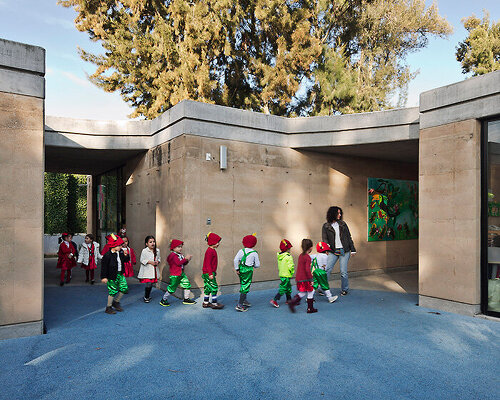tree centers rammed earth preschool in mexico by Tatiana Bilbao
Architect Tatiana Bilbao and her team’s preschool extension for the Liceo Franco Mexicano in Zapopan, Mexico, is a place where early childhood education is grounded in nature, tactile experience, and flexible learning. Built using rammed earth and organized into a series of compact modules, the École Maternelle is conceived as a small world tailored to the scale and imagination of children aged three to six. At the center of the complex, a single tree serves as both landmark and anchor, radiating spatial and emotional continuity across the campus.
images courtesy of Tatiana Bilbao
exploring architecture’s role in early childhood education
Tatiana Bilbao’s Liceo Franco Mexicano extension rethinks what a learning environment can be when architecture becomes a sensory tool. From the start, the design team approached the project as a chance to explore how materiality, form, and spatial rhythm could directly support early childhood development. ‘We understood this as an opportunity to explore how architecture could respond to early childhood through materiality, form, and connection to the environment,’ the Mexico-based architects share. In response, they worked almost exclusively with locally sourced materials, integrating vernacular techniques with a commitment to sustainability and environmental performance.
a place where early childhood education is grounded in nature, tactile experience, and flexible learning
Each classroom in Liceo Franco Mexicano has its own patio
The campus spreads across 2,468 square meters as a series of 8×8-meter modules, each placed to shape a sequence of indoor classrooms and outdoor patios. This modular rhythm allows for fluid transitions between inside and outside, where outdoor spaces are not just auxiliary but pedagogical, offering opportunities for play, discovery, and direct interaction with the landscape. The walls, built with compacted layers of earth, radiate warmth and texture, encouraging touch and exploration. The changing light, natural shadows, and earthy hues all work together to create a calm, immersive environment for young learners.
Every classroom opens onto a patio, a move that erodes the conventional boundary between nature and building. This connection to the outdoors was not a peripheral decision but central to the educational philosophy behind the project. ‘Our intention was to encourage direct contact with nature through a palette of textures, colors, and shifting light,’ the architects note. The layout promotes flexible configurations, able to adapt to different activities and seasons, while always maintaining a sense of orientation around the central tree, an organic axis that ties the whole together.
the École Maternelle is organized as a small world tailored to the scale and imagination of children
Tatiana Bilbao’s preschool extension for the Liceo Franco Mexicano is built using rammed earth
the team worked almost exclusively with locally sourced materials
a commitment to sustainability and environmental performance
changing light, natural shadows, and earthy hues work together to create a calm environment
outdoor spaces are not just auxiliary but pedagogical
every classroom opens onto a patio
project info:
name: École Maternelle
architect: Tatiana Bilbao Estudio | @tabilbaoestudio
location: Zapopan, Jalisco, Mexico
area: 2,468 square meters
client: Liceo Franco Mexicano
principal: Tatiana Bilbao Spamer
project manager: Juan Pablo Benlliure
partners: Catia Bilbao, David Vaner, Juan Pablo Benlliure, Alba Cortés, Mariano Castillo, Soledad Rodríguez
design team: Ludwig Godefroy, Eliza Figueroa, Edward O’Donnell, Erika Alfaro, Damian Figueras, Vanessa Guckel
landscape design: TOA
structural engineer: Jorge Cadena
constructor: Enrique Cabrera
model workshop manager: Isaac Monterrosa
model workshop team: Víctor Castañeda, Verónica Nazar, Eliana López, Ángela Silva, Patricia Morales
The post tatiana bilbao shapes rammed earth preschool in mexico around central tree appeared first on designboom | architecture & design magazine.

